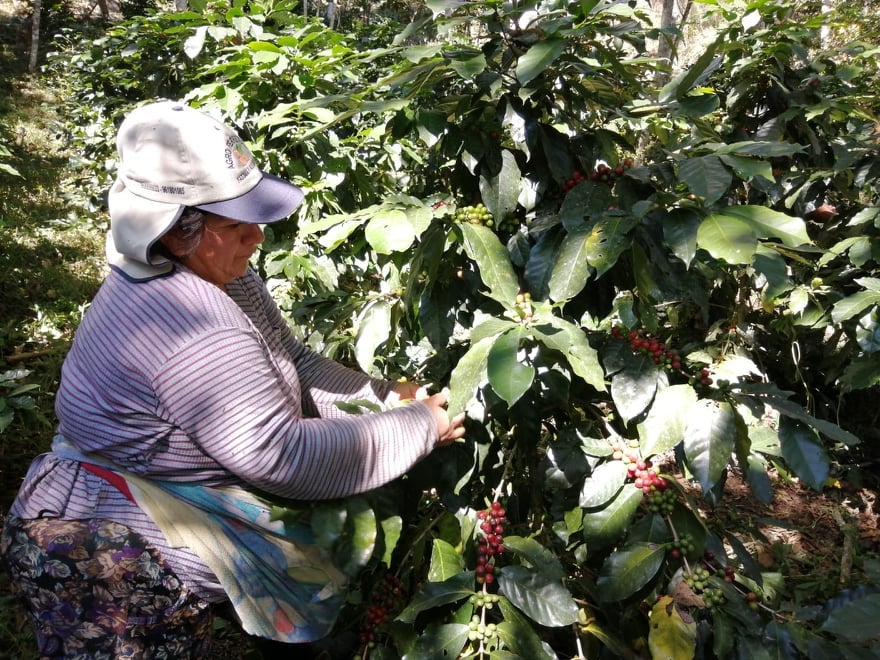News, From the Field
Tuesday, July 26, 2022
Update on the Peru Harvest
Projections for Peru’s harvest are still unclear, says Felice Chay, Latin America Origination Coordinator. There are a number of factors including heavy rains, previous years of low market prices, rising costs of production and potential smuggling into Colombia that are affecting this year’s export potential. Even though those factors make it difficult to anticipate the exact size, price and quality of this year’s harvest, we sat down with Felice Chay (and one of our resident experts in sourcing from Peru) to learn as much as we could about the conditions in Peru and how those may affect this year’s crop.

Heavy Rains Impact Crop Size
The weather this year has been extremely rainy and the harvest has been late, Felice says. “We are hearing from our suppliers that the crop will be lower than initially projected.” The exact numbers are still unclear and “we’re hearing a range of estimated potential reduction from our contacts, but we’re guessing is that the harvest will be at least 5-10% lower than the previous year.”
While harvest size may be lower, “quality this year has been really good,” Felice says. Heavy rains have made drying a bit more difficult and prolonged, but “the quality we’ve been seeing on pre-shipment samples has been extremely strong and we’re excited about the lots we’ll be bringing in.”
High Internal Prices Drive Competition
“Higher prices are a welcome relief after several years of really low market levels,” Felice says. There are two main factors that are interacting and contributing to high prices in Peru right now.
First, the higher differentials in Colombia - driven by low availability, high input costs and the devaluation of the Colombian Peso - are impacting coffee prices across Central and South America (excluding Brazil). In fact, there are some concerns that Peruvian coffee is being purchased and funneled across the border to Colombia to take advantage of the higher prices.
Second, with the harvest delayed, the flow and availability of coffee has been slower and lower than expected, leading to high internal prices as exporters and coops with contractual obligations to fill compete to buy coffee. On a positive note, this leads to higher prices for producers, which “hopefully helps to offset higher costs of production, since the cost of fertilizer has increased anywhere from 50 to 200% at origin,” Felice says.
These higher prices may also impact the quantity of microlots produced. “We’ve seen in other countries, such as Honduras, that when local market prices are high, there’s less incentive to invest the additional time and effort into producing microlots. We’re not sure yet whether we’ll see the same situation in Peru, but it is a possibility that there will be lower availability of microlots this year,” Felice says.
Logistics Slowdowns May Affect Exports
Another consideration this year is logistics. Due to the coronavirus pandemic, the past few years have been difficult for logistics globally. This year in Peru in particular is going to be especially thorny, Felice says. “There have been a number of transportation strikes that are actively delaying coffee shipments in Peru. They have really impeded the movement of coffee to port and we’ve had some containers rolled to the next month because they were unable to reach the port in time.”
Persistent rains have also complicated transportation. Heavy rains earlier in the season washed out sections of highways and caused mudslides or landslides that blocked roads.
“In general, Peru imports this year are going to land later than normal,” Felice says.
Our Sourcing Strategy
In the face of all these challenges, it’s vital that we have a strong sourcing strategy. Our strategy is to diversify our connections and work with a range of suppliers to help us find whatever qualities our clients are looking for. These strong but varied partnerships also ensure that our sourcing is flexible: if weather or logistics delay needed coffees, we can work with other supply partners to fill the gap until the initial coffee can arrive.
“We diversify our suppliers in Peru and across Central America to enable us to find any coffee that any of our destination offices might be looking for,” Felice says. In Peru alone, Sucafina works with 25 to 30 suppliers at any given time. These suppliers range from cooperatives to private regional exporters to national and multinational exporters.
There’s even a big variety in each of these categories, Felice explains. “We work with cooperatives of many different sizes. Some of our partners produce just 20 boxes of coffee each year and others produce over 500 boxes. It’s a really broad range,” she says.
This year, Peru’s harvest is starting later than normal and may be smaller than expected but quality so far looks good. Logistics delays may mean that Peruvian coffee will be delayed, so it’s a good time to plan ahead. Get in touch with your trader to talk about booking Peru now.